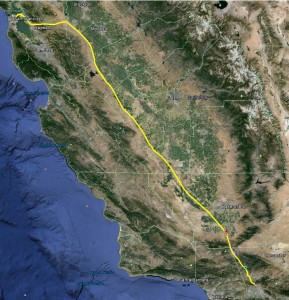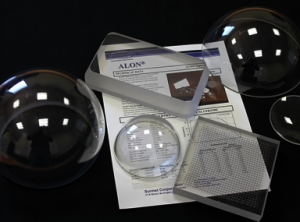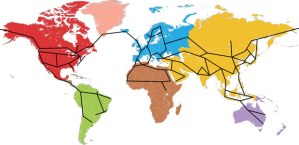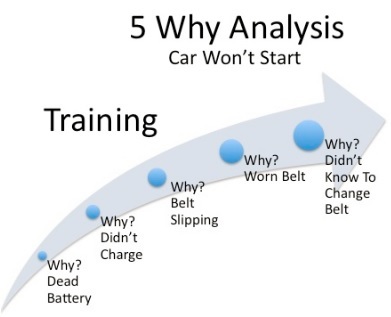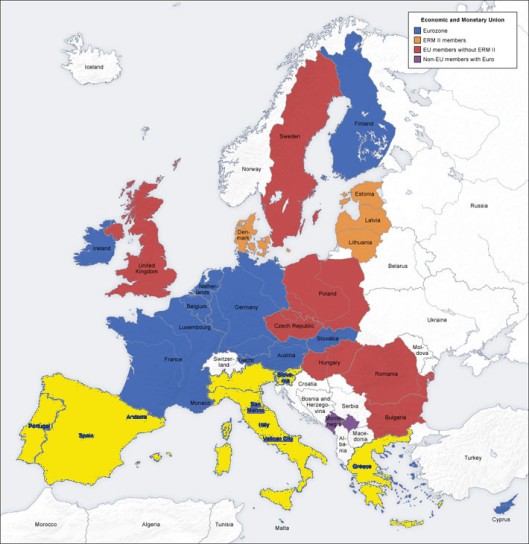Tags
I’ll disagree with Elon’s document where it states that the hyperloop tube can be a single section. (Alpha3.pdf) Essentially, what that design doc says is that the bends will take the thermal expansion and contraction range of half a kilometer.
The current plan is to use steel. Steel has an expansion coefficient of 0.000012 meters per meter-degree C.
Assuming a 65 degree C range of temperature, there will be a length range of 78 cm per 1000 meters. Assuming 640 km of tube, the tube as a whole can vary in length by 499.2 meters, approximately half a kilometer.
The plan calls for the tube to be mounted on pylons that can flex. Assuming a 10 km radius, and an arc of approximately 30 degrees for a section, this works out to a section 5235.9877 m in length. This section can shrink by 4.08 m and expand by 4.08 m from the mean. (This is actually double the change from the mean for this section. However, to use 2.04 m assumes that all installation occurs during the mean temperature, which may not be a safe assumption.) If we assume the arc remains a true radius, the radius will expand to of the tube should move a maximum of 7.79 meters outward or inward.
(I won’t do more than simply mention wildfire as a possible source of heating for sections of pipe.)
However, the tube should not maintain a smooth circular radius. Given that other, straight sections of the tube will also be expanding and contracting at the same time, and that straight tube sections will not deform, a fraction of the total tube’s expansion and contraction will be relieved at curves, and those curves will deform into ellipses. Such a deformation could easily be more than 10 meters sideways.
Designing pylons to accommodate such movements will be challenging.
A further problem is that it will be impossible to produce a completely uniform tube. Every object like this has weak points, and even if it didn’t start that way, repeated flexing will tend to create weak spots.
Yes, steel has probably the best failure mode of any practical material. And steel can cycle through flexing for so long it’s almost indefinite as long as it’s maintained and inspected. Inspection on pylons will be easy. But if it’s avoidable, why not?
Consequently, the tube should be made of sections that fit into each other with expansion joints. I do not believe that this is as big a problem as thought. There are straightforward solutions to the issues.
The joints should have a fitted joint section at least double the length of the expansion from the mean. (e.g. The fitted joins on each end should be at least length of the of the total expansion.) The joint should be beveled and the edge rounded on the female end’s internal surface where it comes back to pipe thickness.
Each tube section will need to be anchored and instrumented on each end to monitor exact location of the join to ensure it does not creep.
Because of the anchoring and monitoring safety requirement, it is desirable that the tube sections be as long as possible. Countering this is the need to make sure that the glide path of the hyperloop car is not affected to the point that it can touch down on the tube, as this will wear both the tube and the air cushion skis.
All this requires is a small increase in the size of the skis to compensate for the gaps at joints. The inertia of the flying car will do the rest. I would choose a tube length of approximately 1 km as the interval. 39 cm of expansion joint should work fine.
A problem is that each joint will introduce a small impulse to rock the car on its linear axis. Taken individually, this is not a problem. But it could be possible for this to resonate with the frequency determined by the length, mass and mass distribution of the car. Those could change. This means that the distances between joints should not be regular.
Holding vacuum in the tube sections will be a little harder, but that just means you need flexible seals outside the pipe. That’s been done for water piping for a long time.
Here’s my wild and crazy. I know that aluminum oxynitride is way too expensive to use for this purpose. But what if a manufacturing process could be created that made it feasible? At least some of the straight sections of pipe could be clear then. And that would be popular. It would make the trip into entertainment as well as practicality.
Aside from that, I’m wondering if hyperloop couldn’t be more valuable for transporting freight.
